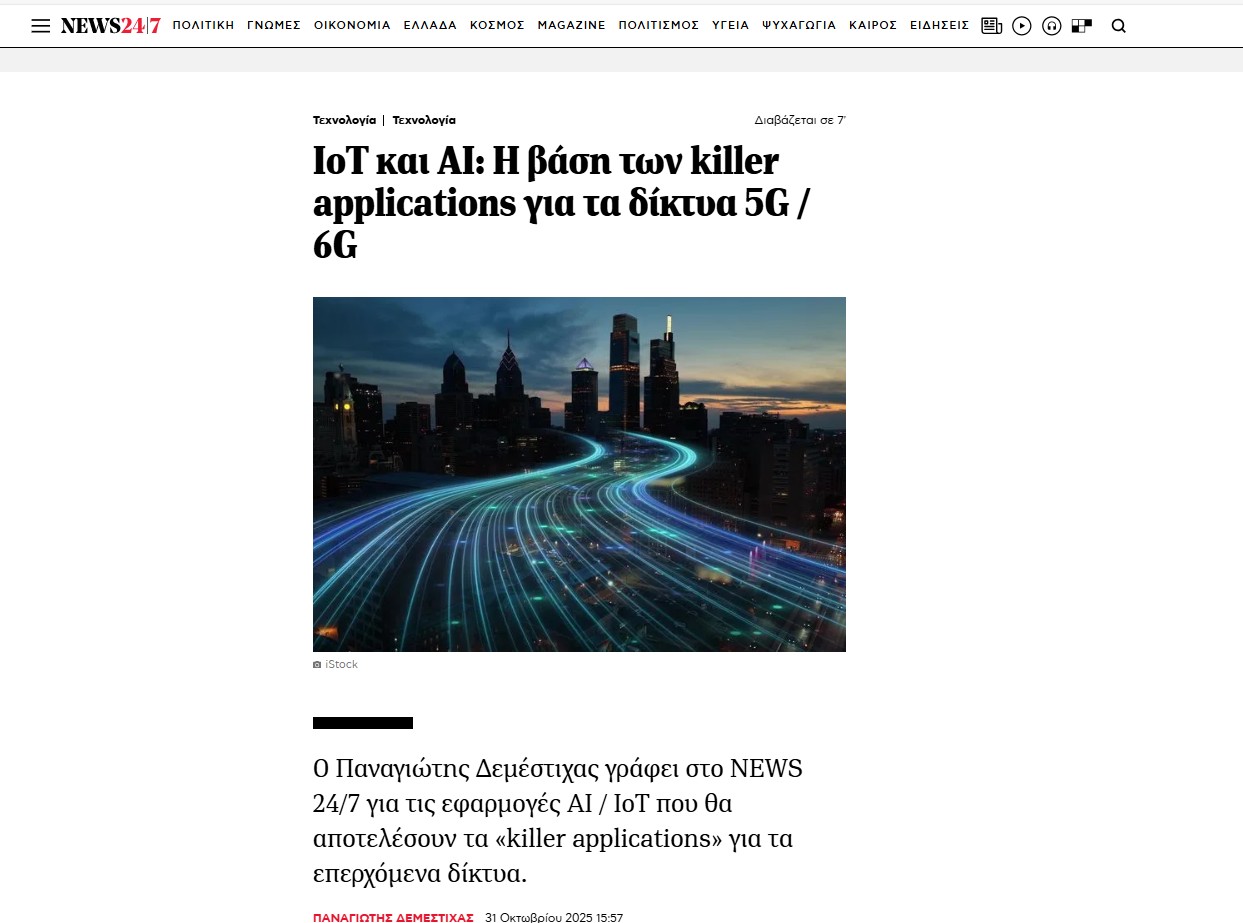Published on 04/11/2025
In a recent article on News 24/7, https://www.news247.gr/technologia/iot-kai-ai-i-vasi-ton-killer-applications-gia-ta-diktia-5g-6g/
Professor Panagiotis Demestichas explores how AI and IoT applications are driving the evolution from 5G to 6G, creating new opportunities for innovation, efficiency, and sustainability. Below is the full English version of the article :
AI/IoT Applications as the “Killer Applications” for the Networks of the Future
By Panagiotis Demestichas – October 31, 2025
Mobile and wireless communication networks have long been part of critical infrastructure. Their timely development, deployment, and smooth operation are essential not only for economic growth but also for ensuring equal opportunities and social cohesion.
This reality has fueled, since the 1980s and 1990s, ongoing cycles of research, development, and standardization that define the successive generations (“Gs”) of mobile communications. From the highly successful 2G/GSM (Global System for Mobile Communications) to the equally transformative 4G/LTE (Long Term Evolution), we are now entering the era of 5G Stand-Alone (5G SA), 5G Advanced, and soon, 6G.
The timely availability of innovative digital applications has always been the decisive factor in the success of each generation. Consider how digital voice services fueled the rise of 2G, and data-driven applications such as web access and social media defined 4G. Demand for new, high-performance applications creates the need for greater network capacity, stricter quality guarantees, and, consequently, new investments in technology and infrastructure. Today, examples include the near-zero latency and error levels required for autonomous vehicles and robotic systems.
These developments raise the question:
What are the next wave of innovative applications that are pushing the evolution of 5G Advanced and paving the way toward 6G?
One direction toward the answer lies in understanding the defining features of our time:
- The ongoing digital transformation across all sectors of the economy and society.
- The increasing integration of Internet of Things (IoT) and Artificial Intelligence (AI) technologies into almost every aspect of our lives.
Through IoT technologies, the physical and digital worlds are becoming tightly connected via smart devices. This enables remote sensing — monitoring the state of the environment or systems — and actuation, or direct influence over that environment. A simple example would be a temperature sensor controlling an air conditioning unit.
Meanwhile, AI technologies empower systems to act autonomously:
- To understand the requirements of the situations they face and predict the consequences of their actions.
- To develop optimal plans, drawing on prior knowledge and interaction with their environment.
- To continuously learn and improve, enhancing their performance and effectiveness over time.
The connecting link for all these functions — sensing, understanding, decision-making, and acting — is the mobile communication network itself. Modern and upcoming networks such as 5G SA, 5G Advanced, and 6G (alongside 4G in certain cases) are no longer just conduits for data transfer. Their role now extends further, encompassing:
- The provision of additional computing and storage resources to support applications end-to-end.
- The exploitation and monetization of network data (always in compliance with privacy and legal frameworks) to benefit applications.
- The use of network slicing and Non-Public Networks (NPNs) to allocate dedicated resources for specific regions, time periods, applications, or user groups.
As networks evolve into full-scale digital infrastructures, they will increasingly provide resources not only for communication but also for data processing and storage. For instance, a network could use location information of devices or robots within a facility, or aggregated data on expected traffic and mobility.
This technological shift opens up vast opportunities for ICT enterprises — from innovative SMEs to larger corporations — to develop solutions that meet societal and business needs through AI, IoT, and next-generation network capabilities.
The WINGS Vision and Role
WINGS ICT Solutions is one such company. Its mission is to create applications that drive transformation across key sectors of the public and private domain. Its technological foundation includes:
- IoT devices: sensors, cameras, gateways, vehicle-mounted On-Board Units (OBUs), robots, and more.
- 5G networks, and beyond.
- AI mechanisms — including machine learning and optimization techniques — for prediction, understanding, decision-making, and knowledge creation.
- Visualization technologies, primarily through web dashboards, mobile apps, and Augmented/Virtual Reality (AR/VR) applications.
With 5G Stand-Alone systems, there is strong confidence that far greater volumes of information will be transmitted more efficiently and with minimal delay, enabling seamless integration between terminal devices and high-performance processors (GPUs). This paves the way for real-time control loops operating within just a few tens of milliseconds — unlocking transformative capabilities such as:
- Environment and citizen protection: near-instant fire detection via AI-based smoke recognition from multiple camera feeds.
- Water and energy network management: operation of dams, pumping stations, and energy transmission infrastructure through digital twins.
- Transportation and mobility: structural health diagnostics, load analysis, and road safety monitoring.
- Agriculture and aquaculture: risk detection via video analytics, protection of livestock or crops from disease, and optimization of production.
- Industry: robotic warehouse systems, real-time quality control of raw materials and products, and 24/7 monitoring of goods in transit.
- Health and wellbeing: continuous monitoring of cardiological, neurological, and respiratory parameters, and accident detection for large populations, anywhere and anytime.
- Education and culture: reimagining the learning experience across all levels, from formal education to lifelong learning, using immersive digital tools.
These are just examples of enterprise (B2B) applications, but numerous consumer (B2C) use cases also exist. When combined, such solutions form the building blocks for smart cities and smart buildings — complex, interconnected ecosystems that enhance efficiency, safety, and quality of life.
The sheer variety of these applications — and the demands they will place on future infrastructure — justify the belief that AI and IoT applications will become the true “killer applications” of upcoming mobile networks. This evolution creates opportunities and value for all stakeholders in the mobile communications ecosystem.
Panagiotis Demestichas
Professor, Department of Digital Systems, University of Piraeus
Co-founder and Chairman of the Board, WINGS ICT Solutions
www.wings-ict-solutions.eu



